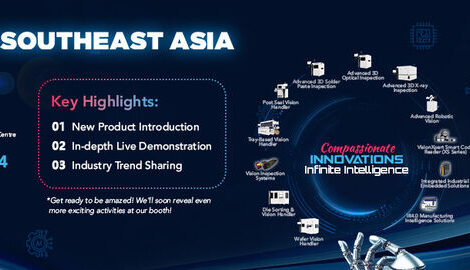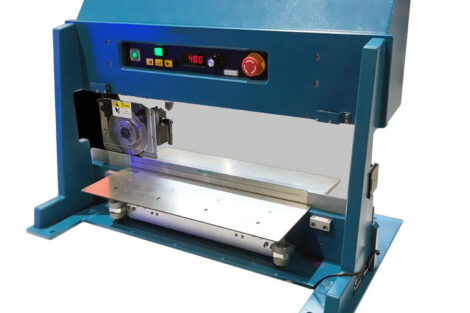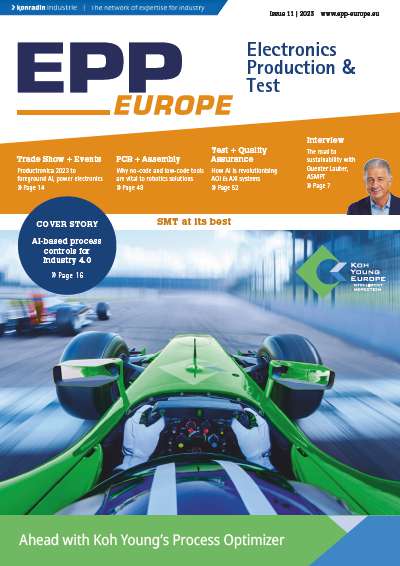Call it timing or coincidence: just as a still fragile manufacturing recovery takes hold in the U.S. – if only in fits and starts as the newly disappointing January data reminded us – this year Apex has found its solid footing. The mood among exhibitors (there were about 500) and attendees (an estimated 5,500) was good if not exuberant. A dense conference program (40 sessions, 125 papers) covered the hot topics of the moment, from lead-free assembly, flip chips, high-frequency testing, embedded passives to process optimization.
IPC president Denny McGuirk is jubilant: “The show is going great”. His quiet but resourceful strategizing over the last couple of years is paying a handsome dividend. Apex is now collocated with the previously separate Printed Circuits Expo and with the Designers Summit under one big roof, the Anaheim Convention Center right across from Disneyland. As a consequence of the collocation, the show now connects OEMs and EMS providers, materials suppliers, PCB fabricators and assemblers as well as their respective design communities and standard setting bodies across the entire process chain, all of them aiming at the peculiar U.S. manufacturing context with its subtle differences to Europe, Japan and East Asia.
Coming right on the heels of Productronica 2003, Apex didn’t have much to offer regarding product news – at least not for the European attendees. But the event provides access for importers to the North American markets and its all-important product designers, buyers and specifiers. As several European exhibitors emphasized, the high-tech impulses and innovations coming from the U.S. military and automotive sectors are pretty much setting the tone for the global manufacturing evolution.
On the other hand, by the sheer presence of European and Asian vendors, the show informs American manufacturers, especially small and medium-size firms, where the world is going in regard to process-chain efficiency and manufacturing automation as well as environmental legislation. Many U.S. companies are just trying to come to grips with the massive outflow of investment, know-how and employment due to the migration of mass-market production to East Asia. The notorious “Buy American” issue is not going to go away soon and needs continued intelligent handling. It has just opened another front as numerous bills are pending in state houses around the country and in the U.S. Congress attempt to restrict the “export” of American jobs. The presidential election campaign now heating up will certainly bring the “Buy American Labor” agenda to the fore, especially as white-collar engineering jobs are beginning to float off-shore. Unemployment among high-tech professionals is currently hovering above 6%.
Accordingly, it served as a healthy, early wakeup call when Solectron CEO Michael Cannon opened Apex with his 8:00 am keynote on how to once again re-engineer the global supply chain for avoiding the sins of the past and adapting to the fact that U.S. manufacturing has to focus on the high-mix/low-volume paradigm (as Europe has regrouped), which requires different and especially suited equipment with the appropriate features. Now that the retrenchment is over for those who have so far survived the deepest downturn in high-tech history, Cannon says, it is imperative to change the way we do business: “EMS providers and OEMs must partner all along the chain to improve performance and maximize collective value.”
Noted tech analyst Walt Custer, in his own keynote presentation, put it much blunter: “Knee-jerk over-ordering and excess capacity,” he assumed, were the main causes for the last two years of misery. Currently, according to Custer, a sustainable recovery here is based on demand. “We are seeing the replacement cycle in computers kicking in again”. As proof: Dell’s sales were up 18% in the fourth quarter of 2003, and also HP could report good business. And the extremely volatile semiconductor market, the analyst said, has made a turnaround as well. That’s good news – but it needs extended monitoring. The bad part: “Chip consumption in the U.S. went from $6bn in 2000, the largest world share, down to the bottom of the barrel – as South East Asia continues to do well”.
Nevertheless, as Apex amply demonstrated, there is a renewed interest in doing deals, mergers and buyouts, providing fresh capitalization, as well as building out plant capacities, refocusing on next technologies and assigning new functionalities to global manufacturing locations. Acceleration of research and development is the declared goal. In this vein, Vitronics Soltec now relies on a triad of manufacturing locations: at new and expanded facilities in Oosterhout, the Netherlands (wave and selective soldering machines), Stratham, NH (reflow) and in Souzhou, China. “We are seeing a lot of activities in Europe and the U.S.,” president Jeroen Schmits pointed out. “We are not leaving. Innovation and creativity in our industry are represented here and not so much yet in China”. In Europe, Vitronics Soltec is focusing on selective and lead-free soldering.
Speedline Technologies with its new owner KPS is ramping up R&D for the next machines as well. “With our process and applications expertise”, president Pierre de Villemejane underscored, “we offer the lowest cost of ownership in PCB and semiconductor manufacturing”. Next, the portfolio company American Capital Strategies Ltd acquired Kester from Northrop Grumman to “break from the defense arena” and move freely into industrial space. With expanded resources, Kester has established a subsidiary in Germany, near the Czech boarder, from where it will address the Eastern European assembly markets under its own brand name. “In the U.S., flexibility is not yet fully deployed,” noted Joerg Widmer of Mimot. “Especially in medium-sized firms, automation hasn’t advanced very far. Many of them are discovering only now that high-mix assembly will be their salvation, meaning they are willing to invest”. The company brought to the U.S. its Triligent feeder system, with a closed-loop control for advancing the tape mechanism in its mid-volume placement machines.
Plenty of partnerships and tech co-operations were announced, such as between Vi Technology and Siemens Dematic, Cyberoptics and Universal, Tecnomatix and Juki as well as Assembleon. Solder manufacturer Indium Corp. and Motorola received the Soldertec Global Award for their collaboration on the Pb-free process which has been utilized in millions of cellular phones worldwide. In other words, research and development as well as investment and buying activities are accelerating almost to the former level.
Still, cautious optimism is the position of Richard Heimsch, president of DEK International and chairman of the Apex trade show committee. “Market-wise and in terms of capacity expansion in Asia, the pace has changed significantly over the last twelve months”, he resumed, “mainly carried by U.S. consumer demands”. Only the wired telecoms are not yet fully participating in the upswing as the cell phone makers do. In sum: Don’t neglect U.S. manufacturing. DEK’s cautions man: “There was a time when people predicted the automotive industry would no longer be in the U.S. Now, fifteen years later, it’s the center of automotive manufacturing on the world”.
Universal Instruments prominently featured its AdVantis platform, reconfigured for mid-volume manufacturers providing a smaller footprint, simpler frame and a lower price point. “We created a streamlined product”, underlined business manager Aaron Saxton, “to serve those customers who are not yet ready for our high-volume Genesis model”. Both machines can be equipped with the high-speed Lightning placement head (with 60ms duty cycle) featuring a radial array of 30 modular spindles that are individually controllable. It was selected for the Apex 2004 Innovative Showcase award.
At Siemens Dematic, reportedly “the world’s leading supplier of logistics and factory automation systems,” Günter Lauber sees the U.S. as a very important and crucial market to cover. “For us, it is imperative to be here. North America is very active in terms of new product introduction (NPI) and high-tech manufacturing systems, not so much anymore in the high-volume segment”. Lean-manufacturing concepts is Siemens Dematic’s strategy now in the Americas. Take out all non-value added cost factors. Establish visibility, flexibility, and transparency, build to order, empower operators and include logistics in the problem solving equation. “If you can eliminate line standstill due to material supply interruptions, you drive up you line load enormously. By doing that, even high-mix production can be kept onshore,” Lauber believed.
For Viscom, Volker Pape was highly satisfied about how booth attendance turned out. “We had to print out even more lead sheets because we got more leads than we had expected”. And, according to Pape, “people are ready to buy. The budgets are there again”. The structural changes coming to U.S. manufacturing, he said, were playing well into Viscom’s strengths. “We have always been at the top end with our equipment. Now we are reaching down to the lower end to match the demands of the American and Asian markets”. Shown were the AOI/AXI combo platform X7055 and the now faster S6055 II, aiming at paste and pre/post solder inspection.
AT Tyco Automation, all energies were focused on covering the entire process chain. “We are a one-stop shop for customers needing capital equipment for assembly processing,” explained George Szekely, general manager of the Automation Group at the richly appointed booth. “We started out as a pick-and-place vendor. Now we offer advanced packaging, odd-form placement, selective soldering, press-fit and pin insertion among others”. Especially press-fit, Szekely believed, is being touted as a problem-free alternative to lead-free soldering.”
Voices on environmental awareness
Lead-free got its own conference session overflowing with curious and anxious attendees and offering an expert panel (Beyond Lead-Free – WEEE/ROHS). Like at Productronica, the discussion turned away from metallurgical aspects and concentrated on those of compliance and the logistics of transitioning to the era of lead-free manufacturing. Here, confusion still reigns as Mark Newton of Dell stated, despite the good will to make the transition at whatever cost involved. WEEE and ROHS (Waste from Electrical and Electronic Equipment/Reduction of Hazardous Substances), according to him, “are a mess because every nation is doing their own enforcement”. (Editor’s note: this EU legislation is valid at least in 25 European nations.) But, as Newton goes further, in the U.S. the fragmentation is even worse, with California insisting on its own, much stricter rules, for instance on the containment of copper. Also Eric Austermann of Jabil, Kay Nimmo of ITRI and Heather Bowman of the Electronic Industries Alliance participated in the panel.
Looking at WEEE/ROHS readiness and implementation, Austermann thinks there still are major infrastructure gaps in the audit trail to be established by manufacturers. Perhaps, he says, there will be an EU clearinghouse in place this spring for these issues. Jabil, according to Austermann, wants to be an innovator in WEEE compliance, defining the responsibilities of OEMs and EMS providers in this regard. China, Austermann said, is set to adopt the EU regulation within the 2006 time frame.
All in all, according to Barry Lee Cohen of Cookson Electronics, the collocation of Apex and Printed Circuit Expo “turned out to be a tremendous opportunity for us as we supply board fabricators and assemblers worldwide”. The industry, Cohen thinks, is in a “responsible recovery”. How long can it last? “I’m not a soothsayer”. Werner Schulz
EPP EUROPE 409
Share:













